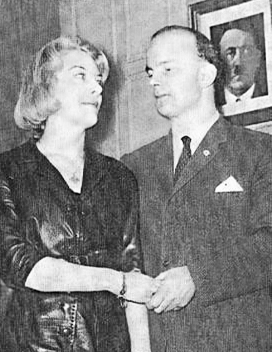
John Hutchyns Tyndall was a British fascist political activist. A leading member of various small neo-Nazi groups during the late 1950s and 1960s, he was chairman of the National Front (NF) from 1972 to 1974 and again from 1975 to 1980, and then chairman of the British National Party (BNP) from 1982 to 1999. He unsuccessfully stood for election to the House of Commons and European Parliament on several occasions.

The National Front (NF) is a far-right, fascist political party in the United Kingdom. It is currently led by Tony Martin. As a minor party, it has never had its representatives elected to the British or European Parliaments, although it gained a small number of local councillors through defections and it has had a few of its representatives elected to community councils. Founded in 1967, it reached the height of its electoral support during the mid-1970s, when it was briefly England's fourth-largest party in terms of vote share.
The League of Empire Loyalists (LEL) was a British pressure group, established in 1954. Its ostensible purpose was to stop the dissolution of the British Empire. The League was a small group of current or former members of the Conservative Party led by Arthur K. Chesterton, a former leading figure in the British Union of Fascists, who had served under Sir Oswald Mosley. The League found support from some Conservative Party members, although the leadership disliked it very much.
The 62 Group, originally the 62 Committee, was a militant broad-based coalition of anti-fascists in London, headed by Harry Bidney. Based on the earlier 43 Group, it was formed in 1962 largely in response to the resurgence of fascism in Britain at the time, and particularly Colin Jordan's National Socialist Movement (NSM). It used violence against the remnants of Oswald Mosley's Union Movement, the original British National Party, and the emerging National Front, as well as the NSM. The group was financed in part by the Jewish Aid Committee of Britain (JACOB).

John Colin Campbell Jordan was a leading figure in post-war neo-Nazism in Great Britain. In the far-right circles of the 1960s, Jordan represented the most explicitly "Nazi" inclination in his open use of the styles and symbols of Nazi Germany. Through his leadership of organisations such as the National Socialist Movement and the World Union of National Socialists, Jordan advocated a pan-Aryan "Universal Nazism". Although later unaffiliated with any political party, Jordan remained an influential voice on the British far right.
Column 88 was a neo-Nazi paramilitary organisation based in the United Kingdom. It was formed in the early 1970s, and disbanded in the early 1980s. The members of Column 88 undertook military training under the supervision of a former Royal Marine Commando, and also held regular gatherings attended by neo-nazis from all over Europe. The name is code: the eighth letter of the alphabet 'HH' represents the Nazi greeting 'Heil Hitler'. Journalist Martin Walker described Column 88 as a "shadow paramilitary Nazi group".

The National Labour Party (NLP) was a British neo-Nazi political party founded in 1957 by John Bean. The party campaigned on a platform of white nationalism, anti-Semitism, and opposition to non-white immigration.
John Edward Bean was a British political activist and writer, who was a long-standing participant in far-right politics in the United Kingdom, and a number of its movements.

Arnold Spencer Leese was a British fascist politician. Leese was initially prominent as a veterinary expert on camels. A virulent anti-Semite, he led his own fascist movement, the Imperial Fascist League, and was a prolific author and publisher of polemics both before and after the Second World War.
The Greater Britain Movement was a British far right political group formed by John Tyndall in 1964 after he split from Colin Jordan's National Socialist Movement. The name of the group was derived from The Greater Britain, a 1932 book by Oswald Mosley.

The Imperial Fascist League (IFL) was a British fascist political movement founded by Arnold Leese in 1929 after he broke away from the British Fascists. It included a blackshirted paramilitary arm called the Fascists Legion, modelled after the Italian Fascists. The group espoused antisemitism and the dominance of the 'Aryan race' in a 'Racial Fascist Corporate State', especially after Leese met Nazi Party propagandist Julius Streicher, the virulently racist publisher of Der Stürmer; the group later indirectly received funding from the Nazis. Although it had only between 150 and 500 members at maximum, its public profile was higher than its membership numbers would indicate.
The British National Party (BNP) was a neo-Nazi political party in the United Kingdom. It was led by John Bean. The group, which was subject to internal divisions during its brief history, established some areas of local support before helping to form the National Front in 1967. Scholar Nigel Fielding described the BNP as having a "firmly Nazi" ideology.

Edward Jeffrey Hamm was a leading British fascist and supporter of Oswald Mosley. Although a minor figure in Mosley's prewar British Union of Fascists, Hamm became a leading figure after the Second World War and eventually succeeded as leader of the Union Movement after Mosley's retirement.
The National Socialist Movement (NSM) was a British neo-Nazi group formed on 20 April, Adolf Hitler's birthday, in 1962, by Colin Jordan, with John Tyndall as his deputy as a splinter group from the original British National Party of the 1960s.
The British People's Party (BPP) was a British far-right political party founded in 1939 and led by ex-British Union of Fascists (BUF) member and Labour Party Member of Parliament John Beckett.
Denis Pirie is a veteran of the British far right scene who took a leading role in a number of movements.
The history of the National Front, a far-right political party in the United Kingdom, began in 1967, when it was founded by A. K. Chesterton.








